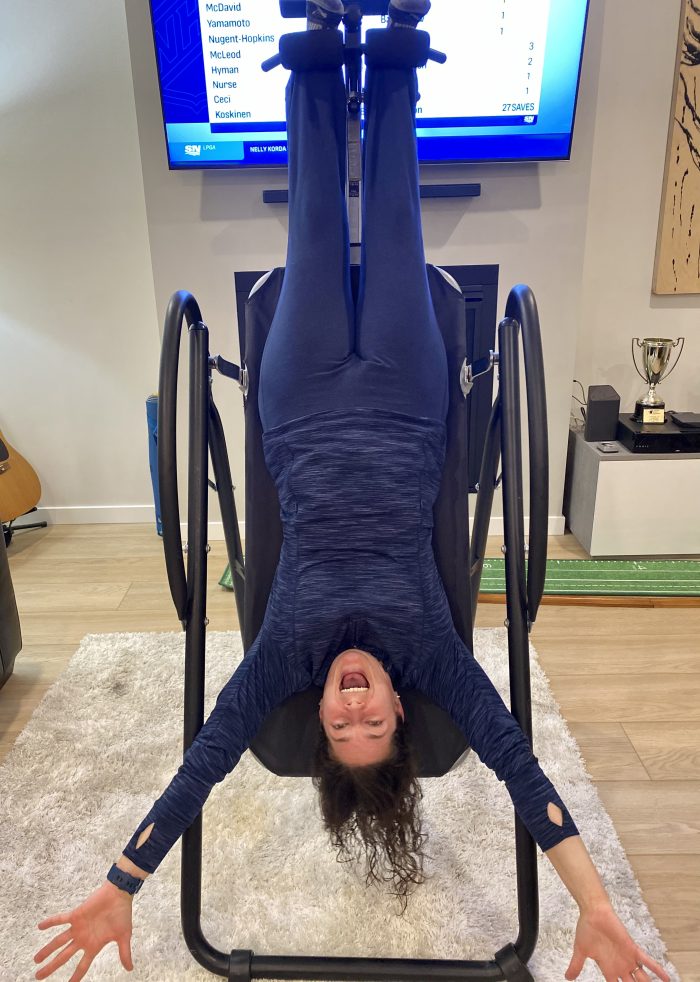Inversion Table for Back Pain: 15 Pros and Cons

Have you ever heard about inversion tables? Is is a bench where you are strapped in by the ankles to flip yourself backwards at an angle or up side down to stretch your lower back by using your bodyweight and gravity. A lot of people swear by it. It helps them release their lower back pain.
One study looked at 47 people with chronic low back pain. They practiced inversion therapy in three 3-minute sets at different angles four times a week over an eight-week period. The study found that inversion therapy at 60 degrees significantly reduced back pain over the study period. It also improved torso flexibility and strength. Read more here: What Are the Risks and Benefits of Inversion Therapy? by Healthline
If your job involves spending a lot of time sitting behind a desk or driving for long period of time, eventually, your nerves at your spine get squished, your muscles at your lower back get tight and your discs and vertebrae at your lower back get too compressed. Consequently, pain and discomfort can occur.

There are some good benefits to get an inverted table. Here is the list of some benefits:
- Return the space between your discs to a more normal level by doing a spinal traction.
- Help with sciatica pain.
- Release muscle spams.
- Relax muscles at lower back.
- Help with kidney stones.
- Can help with scoliosis.
- Your nerves respond better to signals because they are relaxed.
- Increase flexibility.
- Improve posture.
- Increase circulation and blood flow.
- It is easy to find an used one on marketplace.
- Release neck and lower back pain.
Even if the inverted table can be effective for some people, I find there are negative points that should be mentioned. Indeed, inversion therapy doesn’t provide lasting relief from back pain, and it’s not safe for everyone.
- The table itself is bulky and takes a lot of room.
- It can be an expensive tool to use only a few times a year. Prices range from $120 to more than $1,000 for the fanciest models.
- It is not everybody who is comfortable to hang upside down.
- It is not recommended for pregnant women, people with osteoporosis, high blood pressure, heart disease, history of stokes, if you have acid reflux, spinal injuries, inner ear, and eye problems.

If you have an inversion table and would like to know how to use it safely, watch this short video.
If you don’t want to get your own inversion table, I completely understand it. You can try one at a physiotherapist or chiropractor in your town. I have helped several clients with back pain without using an inversion table. You can also release back pain with tennis balls, by adding stretching exercises, doing specific core and back exercises, practicing yoga on a regular basis and get off your butt as much as possible. The body is meant to move and not to spend 12 to 18 hours a day sited.

If you decide to buy an inversion table, please seek for medical advice. If you have a medial condition like high blood pressure, glaucoma, and osteoporosis, don’t buy one. Keep in mind that they are not for everybody to use and you can injure yourself even more…
Read more:
Lower Back Pain: Stretch and Exercise by Abstract Fitness
5 Technics to Release Pain at Your Hip and Lower Back by Abstract Fitness
Why do We Have Back Pain and How to Be Pain Free by Abstract Fitness
Inversion Table Pros And Cons (And Possible Dangers) by Workout HD
What Yoga Poses (asanas) Are Best to Mimic an Inverted Table? by Healthline
The 7 Best Inversion Tables of 2021 by Verywell Health
